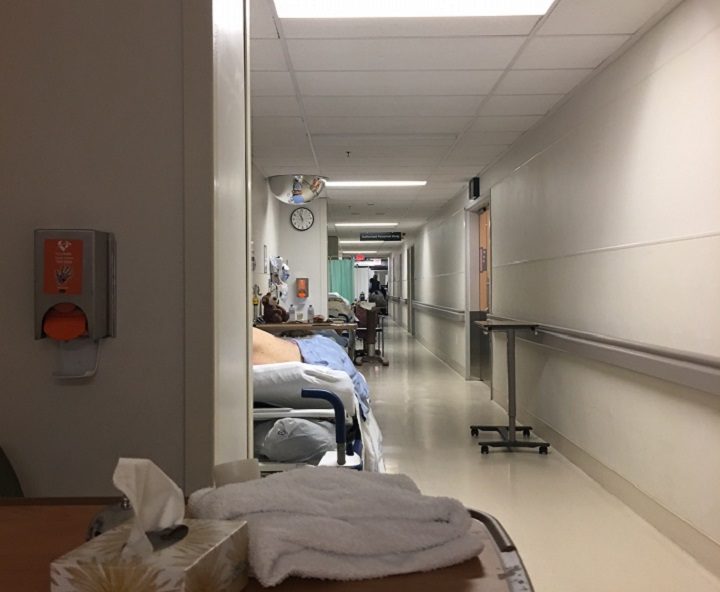Jack Webb died in a Halifax hospital on Feb. 1, after sitting in a chilly emergency room hallway for six hours and being bumped from a room by another dying patient during his five-day stay.

“I believe Jack was terrified. … He wanted to go home,” his wife, Kim D’Arcy, said.
READ MORE: Wife tells how overcrowded Halifax hospital failed her husband
His story isn’t unique. Over the last few months, there have been a flurry of stories from patients across Canada, complaining that they were kept in hospital hallways because of overcrowding.
A woman from Surrey, B.C. recently spent three days in the hallway, after being admitted for internal bleeding.
“When my doctor came to see me, there were people standing around and he was talking about my private, personal information about the treatment I was about to go through,” the woman, Karen Sidhu, told Global News.
“He couldn’t help it. It was really unacceptable.”

Jamie-Lee Ball arrived in Brampton’s ER with intense abdominal pain on March 25. She said she was only admitted after collapsing and screaming in pain on the waiting room floor. She spent five days in corridors on a gurney, unable to eat or drink for days as she awaited test results.
Similar stories have also recently been reported in Ottawa, Abbotsford, Hamilton and Kelowna.
Not enough beds in hospital wards
Dr. Alan Drummond, co-chair of public affairs for the Canadian Association of Emergency Physicians, believes that this problem exists in every province. He says the problem isn’t in the emergency room, but a little further up the chain, in the hospital wards.
“You get a patient that comes to the emergency department, they’re frail, they’re elderly, they’re sick. They need to be admitted. They need to go to a ward bed but they’re stuck. There’s no ward beds to go to so they end up occupying an emergency treatment stretcher,” he said.
“And every time you have somebody occupying a treatment stretcher, that’s preventing patients from being offloaded in an ambulance, and it’s causing a backlog into the waiting room.”
“Unless we’re going to look at your hemorrhoids in the hallway, you’re not being seen until there’s a place to put you.”
According to data from the World Bank, the number of hospital beds per 1,000 people in Canada declined from 6 in 1990 to 2.7 in 2010.
A Canadian study, though less recent, comes to a similar conclusion: the number of hospital beds peaked in 1989, but declined until 2002 – the last year in the study.
Dr. Howard Ovens, the chief medical strategy officer for the Sinai Health System in Toronto, said that hospitals are continuing to struggle to meet the national goal of being able to shift most patients in ER into an in-patient bed within eight hours.
Indignity and medical complications
“It’s not pleasant to sit in a waiting room for eight hours with a bunch of sick other people,” said Drummond, though he is more concerned about people lying in hallways than sitting in the emergency waiting room.
“That’s where you have your mother or grandmother in the hospital, admitted but can’t get to the ward. So they end up in a hallway. A brightly-lit, noisy hallway where there’s no toileting facilities, there’s no privacy, their basic human needs are unmet,” he said.
“There’s a basic level of human suffering that simply cannot be accepted in a country as rich as ours.”
Not only that, but people who spend prolonged periods in hospital hallways are at higher risk of infection, aren’t getting adequate treatment, and “die more frequently,” he said.

Drummond believes that the ultimate solution is to have more beds and to manage them better. Too much focus has been on improving primary care, he said, which he doesn’t think helps to solve the problem at the hospital.
Other physicians agree that existing beds need to be better managed.
Dr. Grant Innes, an emergency physician at the University of Calgary, co-authored a paper which studied 29 Canadian hospitals and found that patients were spending an average of about 48,000 hours a year in ERs due to being “blocked” from entry into other wards.
He calculates this is only about 1.5 per cent of overall bed hours at the hospitals, prompting him to argue much of the problem may be solved if hospitals improve their management of existing beds.
“In our system, accountability is vague … If nobody is accountable to solve a problem, solutions are unlikely to appear,” he said, adding that too many medical departments are content to shift their problems into other parts of the hospital.
— With files from the Canadian Press
Have you experienced a long stay in a hospital hallway? Tell us your story using the form below.
Note: We may use your response in this or other stories. While we may contact you to follow up, we won’t publish your contact information.


Comments